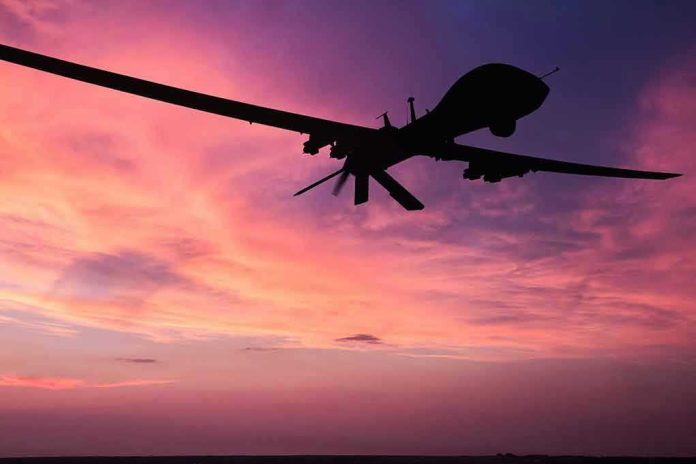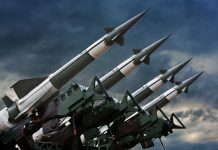
Taiwan’s announcement of a staggering 48,750 military drone procurement plan—a sixteen-fold increase from current levels—signals the island democracy’s most aggressive defense buildup yet as Communist China’s military threats reach unprecedented heights.
Story Highlights
- Taiwan orders 48,750 domestically-produced military drones by 2027 in $1.68 billion defense surge
- Procurement represents 16-fold increase from current levels as China escalates airspace violations
- Strict domestic sourcing requirements exclude all Chinese components and capital
- Plan exemplifies asymmetric warfare strategy to counter China’s overwhelming conventional military advantage
Historic Defense Buildup Responds to Communist Aggression
Taiwan’s Ministry of National Defense announced the unprecedented drone procurement plan in July 2025, marking the largest military drone acquisition in the island’s history. The Armaments Bureau’s tender specifically calls for five categories of unmanned aerial vehicles, including multi-rotor, fixed-wing, and hybrid UAVs, with phased delivery of 11,270 units in 2026 and 37,480 in 2027. This massive expansion comes as Beijing continues ramping up military pressure through frequent airspace incursions and Taiwan Strait median line crossings.
The timing reflects Taiwan’s recognition that traditional defense strategies won’t work against China’s massive military machine. According to multiple defense sources, Chinese aircraft have been conducting record numbers of sorties into Taiwan’s Air Defense Identification Zone, creating an urgent need for cost-effective deterrence measures that don’t break the bank or rely on foreign suppliers who might buckle under Beijing’s pressure.
Domestic Manufacturing Requirements Block Chinese Infiltration
Taiwan’s defense planners learned hard lessons from China’s economic warfare tactics, implementing strict domestic sourcing requirements that completely exclude Chinese components and capital. This move protects against supply chain vulnerabilities and potential sabotage—smart thinking given Beijing’s track record of weaponizing economic dependencies. The procurement specifically prioritizes local manufacturing capabilities, ensuring Taiwan maintains control over its defense industrial base rather than relying on suppliers who could be compromised or cut off during a crisis.
China has already demonstrated its willingness to use economic pressure as a weapon, tightening export controls on rare earth magnets in April 2025 that directly impact Taiwan’s drone supply chain. This aggressive move validates Taiwan’s decision to prioritize domestic sourcing, even if it creates short-term bottlenecks. Industry experts note that current Taiwanese manufacturers can produce 8,000-10,000 drones annually, requiring rapid expansion to meet the ambitious 2027 targets.
Asymmetric Strategy Offers David vs. Goliath Solution
Taiwan’s drone surge represents textbook asymmetric warfare—using relatively inexpensive, mobile systems to counter an adversary’s overwhelming conventional superiority. Each drone costs a fraction of traditional military aircraft while providing surveillance, reconnaissance, and potential strike capabilities that complicate Chinese invasion planning. Defense analysts widely praise this approach as the most realistic path for Taiwan to maintain deterrence without bankrupting itself trying to match China’s military spending dollar-for-dollar.
The “porcupine strategy” makes perfect sense for Taiwan’s geographic and strategic situation. Thousands of drones can be dispersed across the island, hidden in civilian areas, and rapidly deployed to swarm potential invasion forces. Unlike expensive fighter jets or naval vessels that present high-value targets, drone swarms are resilient, replaceable, and extremely difficult for conventional forces to counter effectively. This represents exactly the kind of innovative thinking American conservatives have long advocated—working smarter, not just harder, to defend freedom.
Industrial Base Strengthening Builds Long-Term Resilience
Beyond immediate defense needs, Taiwan’s drone procurement promises to transform its defense industrial capacity and potentially create export opportunities. Companies like Coretronic and Thunder Tiger, which secured initial contracts in 2023, now face the challenge of rapidly scaling production while maintaining quality standards. Industry analysis suggests the procurement provides crucial stability for domestic manufacturers, enabling long-term planning and investment in advanced capabilities.
The broader implications extend well beyond Taiwan’s shores. Success in building a robust domestic drone industry could position Taiwan as a regional technology hub, offering democratic allies an alternative to Chinese-made systems that often contain surveillance capabilities and backdoors. This aligns perfectly with broader efforts to build trusted supply chains among free nations, reducing dependence on authoritarian regimes that view economic relationships as weapons rather than mutual benefits.









